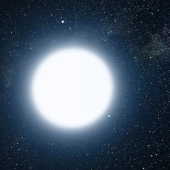ESA Science & Technology - Gaia
Fact Sheet
News
News
12 rare Einstein crosses discovered with Gaia
Thanks to ESA's star mapping spacecraft Gaia and machine learning, astronomers have discovered 12 quasars whose light is so strongly deflected by foreground galaxies that they are each visible as four distinct images, called an 'Einstein cross'.
Gaia's new data takes us to the Milky Way's anticentre and beyond
The motion of stars in the outskirts of our galaxy hints at significant changes in the history of the Milky Way. This and other equally fascinating results come from a set of papers that demonstrate the quality of ESA's Gaia Early third Data Release (EDR3), which is made public today.
Galactic crash may have triggered Solar System formation
The formation of the Sun, the Solar System and the subsequent emergence of life on Earth may be a consequence of a collision between our galaxy, the Milky Way, and a smaller galaxy called Sagittarius, discovered in the 1990s to be orbiting our galactic home.
Milky Way's warp caused by galactic collision, Gaia suggests
Astronomers have pondered for years why our galaxy, the Milky Way, is warped. Data from ESA's star-mapping satellite Gaia suggest the distortion might be caused by an ongoing collision with another, smaller, galaxy, which sends ripples through the galactic disc like a rock thrown into water.
Global Gaia campaign reveals secrets of stellar pair
A 500-day global observation campaign spearheaded more than three years ago by ESA’s galaxy-mapping powerhouse Gaia has provided unprecedented insights into the binary system of stars that caused an unusual brightening of an even more distant star.
Gaia untangles the starry strings of the Milky Way
Rather than leaving home young, as expected, stellar 'siblings' prefer to stick together in long-lasting, string-like groups, finds a new study of data from ESA's Gaia spacecraft.
































